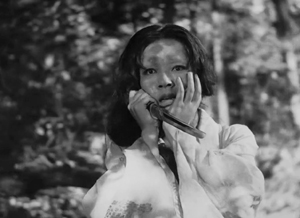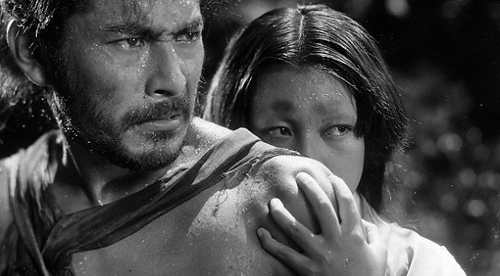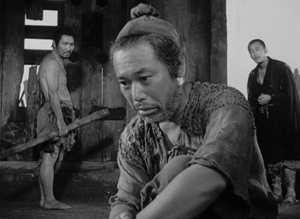
Your complimentary articles
You’ve read one of your four complimentary articles for this month.
You can read four articles free per month. To have complete access to the thousands of philosophy articles on this site, please
Films
Rashomon
Matt Qvortrup contemplates the fleeting nature of truth through Akira Kurosawa’s masterpiece.
“It’s all a lie!” – one of the most famous quotes from Rashomon. That’s not a standard line in a blockbuster; but then again, this is not your average film. This is a movie about the nature of truth. In short, this is an epistemological motion picture, and a Japanese masterpiece at that [epistemology is the study of knowledge and belief, Ed.]. The cinematographic classic was described by the Internet Movie Database as “perhaps the finest film ever to investigate the philosophy of justice”, and Akira Kurosawa’s 1950 epic is, of course, that too; but it is above all an epistemological treatise in the form of a black and white movie. This is the philosophies of Richard Rorty, Thomas Nagel, and all relativists rolled into one, and presented through the Eleventh Century tale of a murder of a samurai and the rape of his wife. Or that’s how it appears.
The Birth of a Legend

“What just happened? Don’t ask me!”
Rashomon had a difficult gestation. Daiei, the production company, was not too enthusiastic about the project. And their attitude towards the then thirty-nine-year-old Director – who had made the propaganda film Sanshiro Sugata Part II in the last year of the Second World War – was not improved when he overspent the $140,000 budget building a replica of the eponymous city gate and splashing out on four fire engines to create the effect of the pouring rain which causes the protagonists to seek shelter under it.
Part of their reluctance was due to the – to put it mildly – unorthodox storyline. Not surprisingly, the company did not put the film forward for the Venice Film Festival for 1950, on the grounds that it was not representative enough of the Japanese movie industry. It was instead entered by an Italian Japanologist, Giuliana Stramigioli. However, later Rashomon went on to win the Golden Lion, the highest prize at said festival, and introduced Japanese cinema to the world. The US National Board of Review named it the Best Foreign Film of the Year, and Kurosawa as Best Director. The rest, as the cliché goes, is history. The film was even mentioned in an episode of The Simpsons, when Marge says, “C’mon Homer, you liked Rashomon.”
No Ultimate Revelation
A woodcutter and a priest seeking shelter from the rain at the South Gate of Kyoto, ‘ Rasho mon’ (‘mon’ means ‘gate’ in Japanese: the movie should actually be called Rasho Mon) discuss the recent crime. In flashbacks to the crime and the trial, four different characters – the woodcutter, the wife, the robber, and the dead samurai (through a clairvoyant) – recount the tragic tale differently. Modern film students talk about the ‘ Rashomon Effect’: the presentation of different perspectives before we, at the end, are presented with what actually happened. Except in the original, Rashomon, there is no final vantage point; no privileged perspective; no ‘what actually happened’.
As retold by Tajomaru, the notorious highwayman (played by Kurosawa regular Toshiro Mifune), he lured the samurai into the woods, tied him to a tree, and seduced his wife. Realising her shame, the wife (played by Maehika Kyo), urges Tajomaru to kill the cuckolded husband. But the highwayman, being a man of some honour, frees the nobleman. In the sword fight that follows (one that allegedly inspired Star Wars), the samurai is slain. Or so says the bandit.

Rashomon images © Daiei Pictures Ltd 1950
Yet in her evidence to the court, the wife presents a different story – one that suggests that she fell into a trance while holding her husband’s knife. And after she woke up, he had been killed – perhaps even by herself.
This account is itself contradicted by the samurai’s recounting of his own tragic fate through the clairvoyant. Surely this must be the correct version – for after all, as one of the characters remarks, a “dead man doesn’t lie.” But this seeming truism is immediately countered by the question, “Why not?” – for “If men lie in this world, what makes you so sure they’ll be honest in the next?”
This sort of questioning, indeed, this degree of scepticism, almost makes the movie an illustration of René Descartes’ maxim “If you would be a real seeker after truth, you must at least once in your life doubt, as far as possible, all things” (Principles of Philosophy, 1644). And yet, the epistemological questioning is deeper and more uncompromising in this movie than even in the French philosopher’s maxim, for it questions even the possibility of knowledge, and it touches upon questions of ethics and justice, as well as on those pertaining to knowledge. Whereas Kurosawa’s The Seven Samurai (1954) can be analysed through the perspective of Post-Hegelian metaphysics (See Philosophy Now Issue 55, 2006), Rashomon tackles the fundamental question of the possibility of objective truth, even to the point of occasionally filming the story literally from the protagonists’ perspectives. One can speculate endlessly about the symbolism of the gate, it’s significance as if the characters are entering a higher level of consciousness. Only they don’t. Rather like for the characters in Samuel Beckett’s Waiting for Godot (which was written two years later), their waiting is pointless, and no higher understanding is achieved, no truth about the alleged murder is ultimately revealed. Whichever perspective is taken, the conclusion is still the one uttered by Tajomano: “Most of the time we can’t even be honest with ourselves.”
The Nineteenth Century German historian Leopold von Ranke believed it was possible to record history “ wie es eigentlich gewesen” – “as it actually happened.” He wanted, and believed it was possible, to record history faithfully and accurately. Rashomon is a frontal assault on such positivist and realist notions. Rather, it is summed up in the conclusion of the woodcutter: “In the end, you cannot understand the things men do.”
The Art of ‘Truth’

“I don’t know what’s going on, either”
Whether intentionally or not, Rashomon cuts to the chase, or to the core problem, of epistemological relativism. As with recent philosophers who, like Thomas Nagel, take issue with the possibility of a ‘view from nowhere’, so too does Kurosawa’s adoption of Ryunosuke Akutagawa’s short story. As in Nagel’s book The View From Nowhere (1989), the fundamental problem Kurosawa is dealing with is “how to combine the perspectives of a particular person inside the world with an objective view of the same world” (The View From Nowhere, p.3). But compared to Nagel (who also famously pondered “what is it like to be a bat?”), Rashomon is less conclusive, less abstract, and much more entertaining. Not only does the movie contain some of the most poetic lines ever to have been uttered on screen – for example, “human life is truly as frail and fleeting as the morning dew” – it is also a tour de force in techniques that now seem entirely forgotten. At a time when epic music scores and overblown sound effects distract from the visuals, Rashomon is characterized by exquisite uses of silence. This was a deliberate choice. Kurosawa lamented the passing of silent movies, and yet he recognized that it was impossible to turn back the clock. He later recalled, “Since the advent of the talkies in the 1930s, I felt we had misplaced and forgotten what was so wonderful about the old silent movies. I was aware of the aesthetic loss as constant irritation. I sensed a need to go back to the origins” (Stuart Galbraith, The Emperor and the Wolf: The Lives and Films of Akira Kurosawa and Toshiro Mifune, 2003).
However, these aspects, important though they are, are but mechanisms for conveying the epistemological questions which lie at the heart of this movie. The context of a horrific crime makes the reflections on the nature of ‘truth’ more than merely an academic pursuit. Add to this the tenderness shown to an abandoned baby at the end of the film (to say more would be a spoiler!), and this film covers all aspects of the human condition. This, combined with bravura performances by actors at the very height of their powers, more than explains why Rashomon is cited as a major inspiration for directors from Bernardo Bertolucci via Francis Ford Coppola to George Lucas. Rashomon is both a quintessential Japanese movie and a timeless commentary on the notion that “a truth was made rather than found”, as Richard Rorty once put it in The London Review of Books (Vol.8, No.7, p.3, 1986).
Perhaps the most fitting thing that can be said about this action-packed, carefully choreographed, supremely poetic and superlatively-executed movie is its opening line: “I don’t understand it. I don’t understand it at all!” And for a philosopher, recognising this is, perhaps, the beginning of wisdom.
© Matt Qvortrup 2018
Matt Qvortrup is Professor of Political Science at Coventry University.









